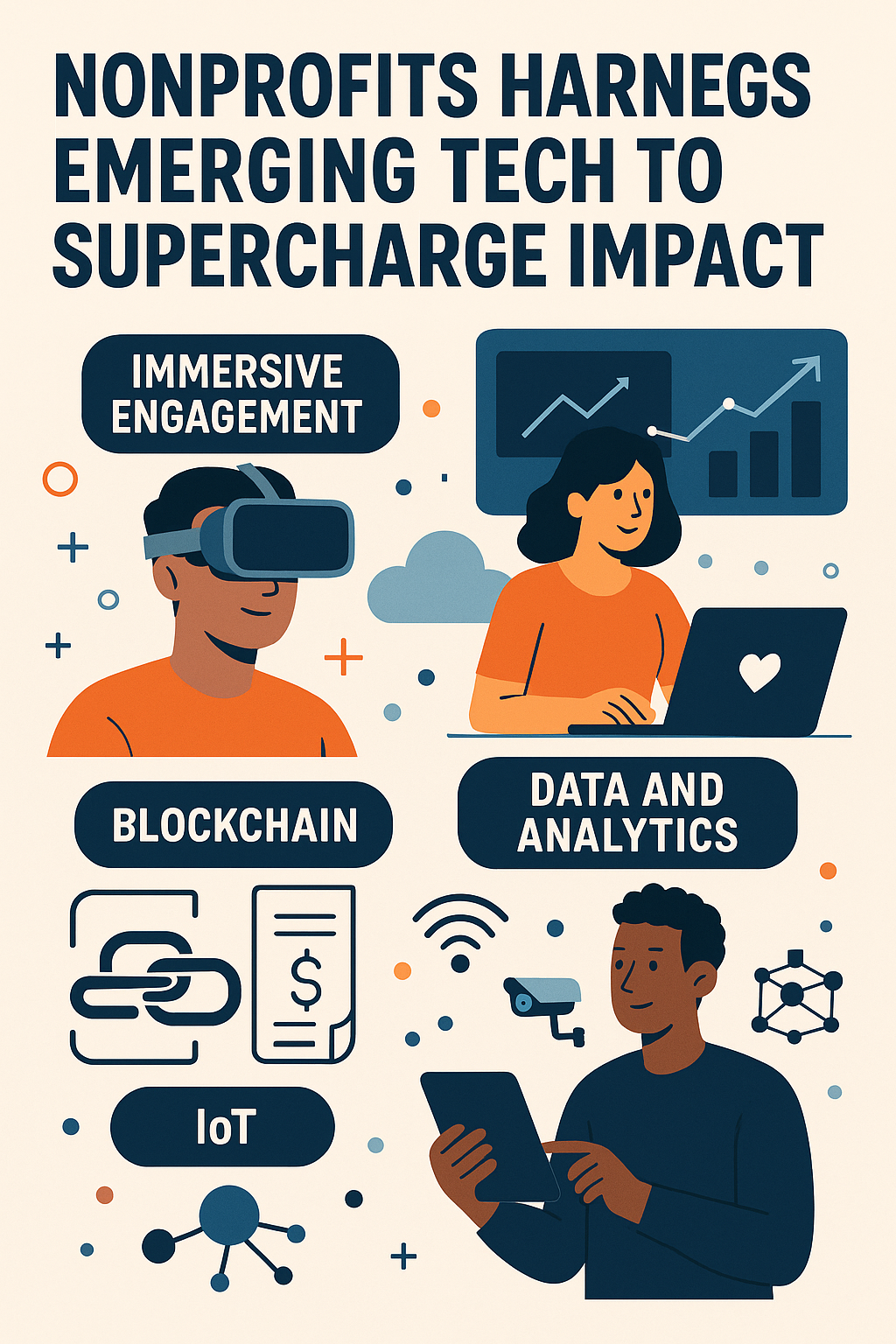Nonprofits Harness Emerging Tech to Supercharge Impact
Partner Spotlight: Mytek Pros – Powering Nonprofit Missions with Smart IT
When it comes to turning big ideas into operational reality, technology infrastructure matters. That’s where Mytek Pros, a San Diego-based managed service provider, becomes a game-changer. Known for delivering structured cabling, advanced cybersecurity, cloud services, and 24/7 IT support, Mytek Pros helps nonprofits build the solid tech foundation they need to thrive. From securing donor data to enabling hybrid work setups and supporting sensor-based programs, Mytek Pros ensures nonprofits have reliable, scalable systems to support their mission. In an age where digital capability equals organizational impact, partners like Mytek Pros are the unsung heroes behind many of today’s most innovative nonprofit success stories.

In today’s wired world, even causes that sound “analog” – wildlife protection, education, health – are going digital. Nonprofits are discovering that artificial intelligence, data analytics, and immersive media aren’t just for Silicon Valley. In fact, a recent survey found 65% of charities are open to using AI, though only about 12% have done so yet. That gap is rapidly closing as resourceful organizations weave new tech into fundraising, outreach, and programs.
Consider the case of a conservation ranger in Kenya. Ranger Amina straps a small transmitter to her backpack before heading out at dawn. This low-power sensor is part of the Northern Rangelands Trust’s huge IoT network – Africa’s largest – spanning 7.4 million acres. It helps Amina track rhinos, elephants and even poachers by sending real-time location data over the air. Back in Nairobi, the data flows into cloud analytics (EarthRanger), giving park managers maps and alerts. The result? Early reports show a 10% rise in black rhino numbers in protected areas since deployment. This real-world example shows how inexpensive networked gadgets – backed by solid cabling, wireless gateways, and cloud servers – let a small NGO punch far above its weight. Sensors on wildlife and vehicles feed a vast IoT network that Kenya’s Northern Rangelands Trust uses to protect endangered species.
Immersive Engagement: VR and AR Win Hearts (and Wallets)
Engaging donors used to mean heartfelt letters or emotional videos. Now charities are literally transporting people into the story. Virtual reality (VR) can make a distant cause feel immediate and personal. In a notable experiment with the Red Cross, participants who viewed a refugee camp scene in VR gave more money and pledged higher future support than those who saw the same story on a 2D screen. Why? VR evokes stronger emotions and empathy. Alzheimer’s Research UK created a VR experience called “A Walk Through Dementia”, letting volunteers and donors literally step into a patient’s world. Wearers fumble with a virtual grocery list or count impossible change, gaining new insight into a dementia sufferer’s daily challenges.
This immersive empathy pays off. For example, education nonprofit Pencils of Promise hooked wealthy donors with VR headsets at a gala; guests “visited” a classroom in rural Ghana through VR and ended up raising over $2 million for new schools. The lesson: letting people feel the mission makes them far more willing to give. As one study concluded, VR not only boosts immediate donations but even makes people say they’d be more likely to become regular supporters after such an experience. In short, VR (and its sibling AR) are powerful new storytelling tools for nonprofits. They require good graphics hardware and sometimes 360° video, but the technology barrier is falling – a thoughtful VR campaign can turn sympathizers into lifelong champions.
Intelligence and Insight: Data, AI, and Analytics
Behind the scenes, nonprofits are also taking pages from tech companies’ playbooks to work smarter. AI and data analytics are helping organizations segment donors, predict trends, and personalize outreach. Consider nonprofit fundraising platform Funraise: by embedding a cloud analytics engine (Sisense) into its software, Funraise turned static reports into interactive dashboards. Their clients immediately saw trends and key metrics. The results were dramatic – annual online fundraising jumped seven-fold and donor retention improved by about 12% on average once nonprofits could self-serve their data. (By contrast, the average charity typically retains under 35% of donors year-over-year, so even modest gains are meaningful.)
Machine learning and AI are powering creative “assistant” tools too. The World Wildlife Fund, for example, launched a Facebook Messenger chatbot that delivers news about endangered species and guides supporters through the donation process. UNICEF applies AI to analyze donor histories and then uses automated chatbots to answer donor questions and send personalized fundraising appeals. These bots are on call 24/7, keeping potential supporters engaged with instant replies. Meanwhile, on the operations side, AI is solving problems at scale: nonprofits like WattTime use satellite imagery and AI models to pinpoint industrial carbon emitters, identifying “low-hanging fruit” that could cut over 1 billion tons of CO₂ per year if utilized. Agricultural NGOs use AI too – Digital Green’s Farmer.Chat assistant has already reached 6.3 million smallholder farmers via mobile, helping them improve crop yields by roughly 12%. In each case, the “secret sauce” is the same: transform messy data into clear insights.
In practice, this means even modest nonprofits can tap cloud computing and AI libraries without huge budgets. Cloud services (AWS, Azure, Google Cloud) give instant access to powerful databases and analytics tools. A small literacy nonprofit in Chicago, for example, once spent weeks manually compiling donor data; after moving to a cloud CRM and integrated dashboards, they can slice the same analysis in minutes. AI tools can even write first drafts of newsletters, translate content, or power accessibility features – many organizations quietly use services like ChatGPT and Google AI behind the scenes. The bottom line is: data-driven operations help nonprofits understand and engage their communities better, freeing staff to focus on mission rather than manual paperwork.
Secure, Transparent Giving: Blockchain and Beyond
Trust is the currency of philanthropy, and blockchain is emerging as a way to bolster it. Cryptocurrencies and digital ledgers let donors see exactly where funds go, and speed up transactions in places where banking is hard. Some of the biggest NGOs are already experimenting: Save the Children’s #HodlHope crypto fund (launched after Typhoon Haiyan) has collected around $7 million in Bitcoin and other crypto-donations to date. UN agencies are on it too – the UN Refugee Agency (UNHCR) partnered with the Stellar network to send stablecoin-based cash to displaced families without bank accounts, allowing instant, low-cost, fully transparent aid transfers.
Even humanitarian data is moving to blockchains. Doctors Without Borders (MSF) has begun uploading thousands of COVID vaccination records to a blockchain so patients can retrieve their records via mobile phone later. This is more than a gimmick: in places lacking reliable medical infrastructure, a secure personal record can save lives. (One MSF partner reports that in India, over 700,000 people die annually due to inaccessible medical histories – some of which could be prevented with a robust record-keeping solution.) As these examples illustrate, blockchain doesn’t just mean Bitcoin – it can mean tamper-proof ledgers for tracking everything from donations to digital identity. For nonprofits, that adds credibility: donors see the chain of transfers publicly, and stakeholders can verify impact data.
On-the-Ground Connectivity: IoT and Emerging Tools
Back to Ranger Amina in Kenya: her success highlights a broader trend. Nonprofits are deploying Internet of Things (IoT) devices in fields as diverse as conservation, healthcare, agriculture, and disaster relief. Beyond wildlife, consider an environmental NGO in California using sensor networks to monitor air quality in wildfire zones, or a water charity installing smart meters to detect leaks in rural villages. All these projects depend on one thing: reliable network infrastructure. You need structured cabling and wireless gateways to carry IoT data home, as well as centralized dashboards to make sense of it.
Many nonprofits partner with tech firms to build this backbone. For instance, actility platforms and Cisco gateways underlie NRT’s Kenya network. Locally, MyTek Pros (a managed IT provider) might rewire an aging office, upgrade switches, and install secure Wi-Fi to support hundreds of networked sensors and devices. This might sound mundane, but it’s critical: without solid cabling and cloud connectivity, data from VR headsets, AI analytics, or LoRaWAN trackers would never flow. In short, IT infrastructure is the unsung hero of these projects.
Of course, more connectivity means more risk. Nonprofits are increasingly targets for cyberattacks, and some have learned painful lessons. In 2024, OneBlood – a U.S. nonprofit blood bank serving 300+ hospitals – was hit by ransomware. Key systems for labeling and tracking donations went dark, forcing staff to print labels by hand and rely on paper forms just to keep blood supplies moving. Surgeries were delayed and an emergency campaign had to be launched to replenish stock. This incident underscored that even well-meaning organizations need enterprise-grade security.
Fortunately, technical solutions exist. Routine automated backups, multi-factor login, and basic antivirus can block most threats. A managed IT partner can perform regular security audits (PCI, HIPAA, NIST compliance, etc.), implement firewalls, and run 24/7 monitoring. As MyTek Pros advertises on its site, their round-the-clock support “ensures your organization stays operational…minimizing downtime”. For a nonprofit, that kind of proactive service means staff aren’t fire-fighting tech crises; instead, they trust the network and get on with serving the community.
Building a Partnership for Tech-Driven Mission
None of this happens in isolation. Nonprofits often work with tech allies – whether volunteer networks like TechSoup or firms like MyTek Pros – to make the leap. A good managed IT firm becomes part of the team: helping migrate servers to the cloud, designing fail-safe networks, and training staff on new tools. For example, a homeless shelter might work with IT pros to install a resilient Wi-Fi mesh across its campus (so caseworkers can log client info on tablets anywhere), and to secure its donor database offsite. Similarly, when a crisis strikes, NGOs can tap cloud-hosted analytics to instantly map need (as some disaster-response organizations do).
These partnerships amplify impact. They free nonprofit leaders to focus on vision instead of versions of software. And they ensure that investments in AI, VR or IoT don’t go to waste for lack of cabling or cloud readiness. As one technology director put it, “Having an IT partner is like having a backstage crew for a big show – the audience only sees the magic on stage, but the show can’t go on without the tech behind the scenes.” Whether it’s installing structured cabling, setting up cybersecurity, or rolling out an Office 365 platform, managed IT providers play a crucial supporting role. (For instance, MyTek Pros offers tiered plans with 24/7 monitoring, firewalls, and backup services – exactly the kind of guardrails nonprofits need.)
The narrative of nonprofits is changing. It’s no longer just heartstrings and bake sales; it’s cloud servers and code, sensors and story. From VR classrooms that inspired a donor’s generosity, to AI chatbots that nurture loyal supporters, to blockchain that shines a light on every dollar’s journey – technology is amplifying good works. Nonprofits that embrace these tools find they can do more with less, reaching broader audiences and delivering services more efficiently. As these stories show, the future of philanthropy is tech-powered, and it’s already here. By combining mission-driven passion with digital innovation – and by building the IT infrastructure to support it – nonprofits are multiplying their impact like never before.
Sources: Authoritative nonprofit and tech reports and case studies as cited throughout (Stanford SSIR, World Economic Forum, Cambridge research, Axios, etc.).
- How Nonprofits Are Using AI for Climate Action
- Virtual reality for philanthropy: A promising tool to innovate fundraising | Judgment and Decision Making | Cambridge Core
- The Future of Nonprofits Lies in VR - AR Insider
- Funraise boosts fundraising With Sisense | Case Studies
- Nonprofit Donor Retention: How to Secure Long-Term Support | DonorSearch
- How Nonprofits Are Using AI for Climate Action
- 9 Nonprofits Harnessing Blockchain For Social Impact - The Giving Block
- Doctors Without Borders is now using blockchain tech for medical record storage
- How IoT is helping to protect Kenya's most vulnerable animals and natural resources | World Economic Forum
- How IoT is helping to protect Kenya's most vulnerable animals and natural resources | World Economic Forum
- Ransomware attack forces hospitals to find new blood donation sources
- Managed IT Services San Diego | 24/7 IT Support | Mytek Pros










